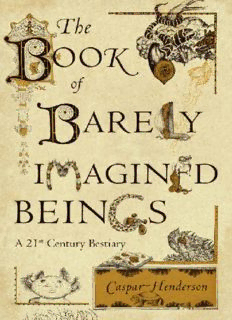
The Book of Barely Imagined Beings: A 21st Century Bestiary PDF
Preview The Book of Barely Imagined Beings: A 21st Century Bestiary
THE BOOK of BARELY IMAGINED BEINGS As centuries pass by, the mass of works grows endlessly, and one can foresee a time when it will be almost as difficult to educate oneself in a library, as in the universe, and almost as fast to seek a truth subsisting in nature, as lost among an immense number of books. Denis Diderot, Encyclopédie, 1755 In our gradually shrinking world, everyone is in need of all the others. We must look for man wherever we can find him. When on his way to Thebes Oedipus encountered the Sphinx, his answer to its riddle was: ‘Man’. That simple word destroyed the monster. We have many monsters to destroy. Let us think of the answer of Oedipus. George Seferis, Nobel Prize speech, 1963 THE BOOK of BARELY IMAGINED BEINGS A 21st Century Bestiary CASPAR HENDERSON the university of chicago press chicago and london Caspar Henderson is a writer and journalist whose work has appeared in the Financial Times, the Independent, and New Scientist. He lives in Oxford, UK. The University of Chicago Press, Chicago 60637 The University of Chicago Press, Ltd., London © 2013 by Caspar Henderson All rights reserved. Published 2013. Printed in the United States. 22 21 20 19 18 17 16 15 14 13 1 2 3 4 5 ISBN-13: 978-0-226-04470-5 (cloth) ISBN-10: 978-0-226-04484-2 (e-book) Originally published in English by Granta Publications under the title The Book of Barely Imagined Beings © 2012 by Caspar Henderson. First published in Great Britain by Granta Books 2012. Library of Congress Cataloging-in-Publication Data Henderson, Caspar, author. The book of barely imagined beings : a 21st century bestiary / Caspar Henderson. pages cm Includes bibliographical references and index. ISBN 978-0-226-04470-5 (cloth : alkaline paper) — ISBN 978-0-226-04484-2 (e-book) 1. Bestiaries. 2. Rare animals. I. Title. QL50.H463B66 2013 591.68—dc23 2012040239 This paper meets the requirements of ANSI/NISO Z39.48-1992 (Permanence of Paper). A serious and good philosophical work could be written consisting entirely of jokes. Ludwig Wittgenstein The world is full of magical things patiently waiting for our wits to grow sharper. Bertrand Russell The true measure of a mountain’s greatness is not its height but whether it is charming enough to attract dragons. from a Chinese poem The most barbarous of our maladies is to despise our being. Michel de Montaigne CONTENTS Introduction ix 1 Axolotl 1 2 Barrel Sponge 25 3 Crown of Thorns Starfish 39 4 Dolphin 51 5 Eel 67 6 Flatworm 81 7 Gonodactylus 99 8 Human 117 9 Iridogorgia 133 10 Japanese Macaque 151 11 Kìrìphá-kò, the Honey Badger 171 12 Leatherback 183 13 Mystaceus 197 14 Nautilus 207 15 Octopus 225 16 Pufferfish 239 17 Quetzalcoatlus 245 18 Right Whale 267 19 Sea Butterfly 283 20 Thorny Devil 295 21 ‘Unicorn’ – the Goblin Shark 305 22 Venus’s Girdle 315 23 Waterbear 321 24 Xenoglaux 331 25 Xenophyophore 341 26 Yeti Crab 353 27 Zebra Fish 367 Conclusion 377 Appendix I: Biological Classification 381 Appendix II: Deep Time 385 Bibliography 389 Thanks 412 Picture Credits 414 Text Credits 416 Index 418 INTRODUCTION O n a bright afternoon in early summer a few years ago, my wife and I took our tiny new daughter out on a picnic. The air was so clear that everything seemed like a hyper- real version of itself. We sat down next to a bubbling stream on grass that glowed in the sunlight. After a feed our daughter fell asleep. I turned to a bag of books, magazines and papers which I tended to carry about in those pre-tablet days and which always contained far more than I had time to read on topics like ecological degradation, nuclear proliferation and the latest conces- sions made to torturers and criminals: the funnies. Also in the bag that day was a copy of The Book of Imaginary Beings – a bestiary, or book of beasts, by the Argentine writer Jorge Luis Borges, first published in 1967. I had last looked at it almost twenty years before and had thrown it in as an afterthought. But as soon as I started to read I was riveted. There’s Humbaba, the guardian of the cedar forest in Gilgamesh, the world’s oldest known poem, who is described as having the paws of a lion, a body covered with horny scales, the claws of a vulture, the horns of a wild bull and a tail and penis both ending in snake’s heads. There’s an animal imagined by Franz Kafka which has a body like that of a kangaroo but a flat, almost human face; only its teeth have the power of expres- sion and Kafka has the feeling it is trying to tame him. INTRODUCTION ix
Description: